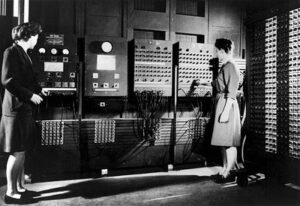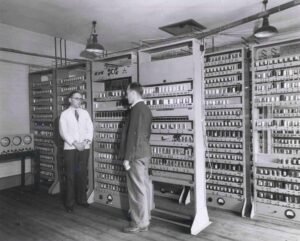20th Century Computing Devices
In the previous topics, we learnt about the early computing devices. Before technology was invented, human beings used fingers, stones and other manual devices to carry out the
counting and calculation of numbers. As time went on, thing started developing, counting and calculating devices came in place. In this topic, we will learn about the 20th Century Computing Devices. Some of them are:
- ENIAC
- EDVAC
- UNIVAC
- DESKTOP COMPUTERS
- LAPTOP
- NOTEBOOK COMPUTERS
- PALMTOP COMPUTERS
ENIAC (Electronic Numerical Integrator And Calculator):

ENIAC was the first of all electronic multi-purpose computer, built on 15 January, 1946 at the University of Pennsylvania, USA.
It was a product of world war II, developed by two professors, John Mauchly and J.
Presper Eckert between 1942 – 1946, to help calculate the firing tables for the united state Army artillery guns. ENIAC was the first high-speed electronic digital computer that used more than 18,000 vacuum tubes, which enabled the machine to store and process data electronically. ENIAC also had the ability to multiply, divide and calculate square roots. Its memory was limited to 20words. . It could add or subtract 5,000 times a second, one thousand times faster than many other machine at that time.
ENIAC weighed 30 tons and occupied a room size of 20 to 40 foot. Each of the 18,000 vacuum tubes generated lot of heat and could only be operated under a powerful air conditioning room.
COMPONENTS OF ENIAC:
ENIAC used more than 2,000 to 18,000 vacuum tubes. It had punched card input and output and used circuits with switches for any required function.
USES OF ENIAC:
ENIAC preformed arithmetic operation faster than any previous machine. It was used for Programming.
EDVAC (Electronic Discrete Variable Automatic Computer):

EDVAC was one of the earliest electronic computers. ENIAC inventors John Mauchly and J. Prosper Eckert proposed the construction of EDVAC in August 1944 and design work for the EDVAC commenced before the ENIAC was fully operational. Like the ENIAC, the EDVAC was built for the U.S. Army’s Ballistic research Laboratory at the Aberdeen proving ground by the University of Pennsylvania’s more school of electrical Engineering. Apart from Eckert and Mauchly, John Von Neumann was later involved in a consulting role. Von Neumann summarized and discusses logical design development in 1945.
EDVAC was a binary serial computer with automatic addition, subtraction, multiplication, programmed division and automatic checking with an ultrasonic serial memory.
COMPONENTS OF EDVAC:
It makes use of Vacuum tubes with a simple processing units. It has a Random Access Memory (RAM).
USES OF EDVAC:
EDVAC stores computer programs, it is used in programming and simplified Architecture.
UNIVAC (UNIVERSAL AUTOMATIC COMPUTER):

It was the first world’s commercial computer designed by J. Presper Eckert and John Mauchly who left university of Pennsylvania in U.S.A over a dispute about who owned the patents and their invention. John Mauchly chose the name UNIVAC in 1944 and J. Presper Eckert and John Mauchly formed a company called Eckert Mauchly Computer Company.
UNIVAC was fully commercialized on June 14, 1951 when the U.S. Census Bureau Officially launched it into service.
It was also part of the first generation computers.
COMPONENTS OF UNIVAC:
UNIVAC was 25 feet by 50 feet in length and contained 5,600 tubes; 18,000 crystal diodes and 300 relays. It made use of serial circuit, 2.25 MHz bit rate and an internal storage capacity of 1,000 words or 12,000 characters. It had a mercury delay line, magnetic tape and the first computer to use buffer memory.
Power consumption was about 120KVA. It was reported that, the processing speed was 0.525 milliseconds for arithmetic functions, 2.15 milliseconds for multiplication and
3.9 milliseconds for division.
USES OF UNIVAC:
UNIVAC was used for general purpose computing, that separated the complex problems of input and output from the actual computation ability.





